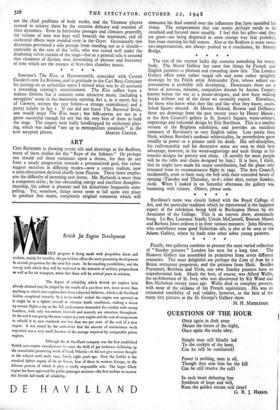ART
CERI RIC.HARDS iS showing recent oils and drawings at the Redfern, many of them studies for the " Rape of the Sabines." Or perhaps one should call them variations upon a theme, for they do not form a steady progression towards a preconceived goal, but rather suggest exercises in differing modes—now a rococo realism, now a semi-abstraction derived chiefly from Picasso. These latter empha- sise the difficulty of inventing new forms. Mr. Richards is more than a competent artist ; he has abounding energy and excellent draughts- manship, his colour is pleasant and his distortions frequently com- pelling. Yet, somehow, things never seem to fall quite into place to produce that major, completely original statement which will announce his final control over the influences that have moulded his vision. The temperament that one senses pet1143i needs to be canalised and focused more steadily. I feel that his gifts—and they are great—are being dispersed in some strange way that prohibits him from showing his full stature. Also at the Redfern is some sweet neo-impressionism, not always pushed to a conclusion, by -Antony
Bridge. * * * *
The rest of the current lucky dip contains something for every- body. The Mayor Gallery has some fine things by French and English painters—a pleasant and rewarding show this. The London Gallery offers some rather turgid oils and some rather sprightly drawings by the Polish artist Aleksander Zyw, whose robust ex- pressionism is probably still developing. Downstairs there are a series of nervous, miasmic, compulsive dreams by Austen Cooper, known before the war as a poster-designer, and now busy making bricks without any of the straw we normally expect. Elsewhere, for those who know what they like and like what they know, estab- lished figures abound. At Messrs. Roland, Browse and Delbanco there are drawings from the past twenty years by Henry Moore ; at the Arts Council's gallery in St. James's Square, water-colours, engravings and industrial design by Eric Ravilious. This is a smaller version of the Brighton exhibition, and provides an excellent summary of Ravilious's so very English talent. Less poetic than Nash, without Bawden's sardonic whimsicality, he nevertheless grew steadily in power as a painter until his death. His self-discipline, his craftsmanship and his decorative sense are seen to their best advantage, however, in his wood-engravings and such things as his transfer designs for pottery and china. (A novelty for most people will be the table and chairs designed by him.) It is here, I think, that he might have made his major contribution, had the plane only returned from its reconnaissance flight in 1942. The Arts Council, incidentally, seem to have rung the bell with their extended hours of opening (Tuesday and Thursday, 10-8 ; other days, except Sunday, 10-6). When I looked in on Saturday afternoon the gallery was humming with visitors. Others, please note.
* * * * Ravilious's name was closely linked with the Royal College of Art, and the particular tradition which he represented is the happiest aspect of the exhibition being held at Burlington House by the Associates of the College. This is an uneven show, atrociously hung. Le Bas, Laurence Scarfe, Ursula McCannell, Bateson Mason and Barbara Jones enliven it in their various manners. John Newton, who contributes some good Sickertian oils, is also to be seen at the Adams Gallery, where he leads nine other sober young painters.
* * * *
Finally, two galleries combine to present the most varied collection of " Sunday painters " London has seen for a long time. The Hanover Gallery has assembled its primitives from seven different countries. The most delightful are perhaps the Lion of Iran by a Beirut restaurant proprietor, and the pictures from Haiti. Besides Peyronnet, Bombois and Vivin, our own Sunday painters have an unprofessional look. Much the best, of course, was Alfred Wallis, the ex-fisherman of St. Ives, who was discovered by Kit Wood and Ben Nicholson twenty years ago. Wallis died in complete poverty, with none of the reclame of his French equivalents. His was an untutored sensibility of real validity, however, as the best of the many tiny pictures at the St. George's Gallery show. M. H. MIDDLETON.


































 Previous page
Previous page